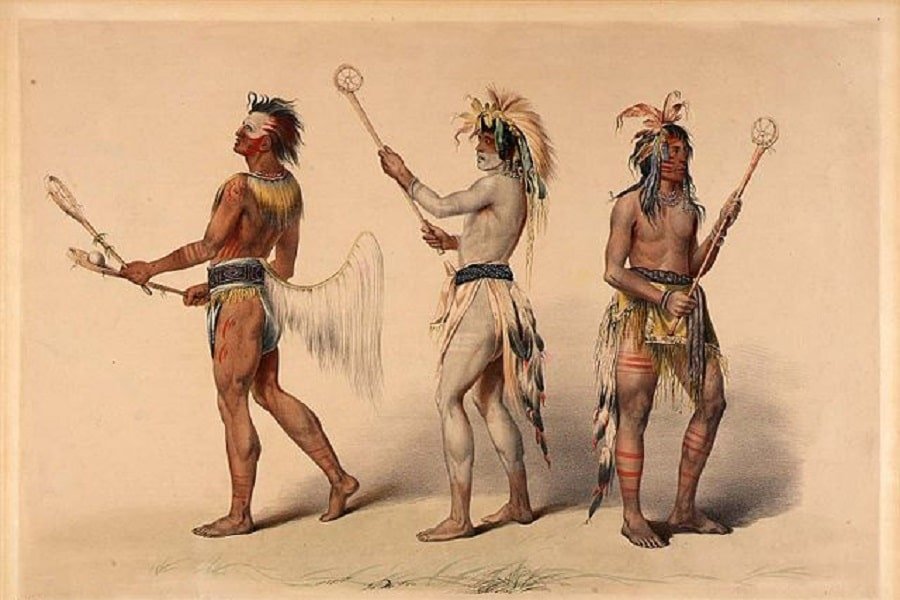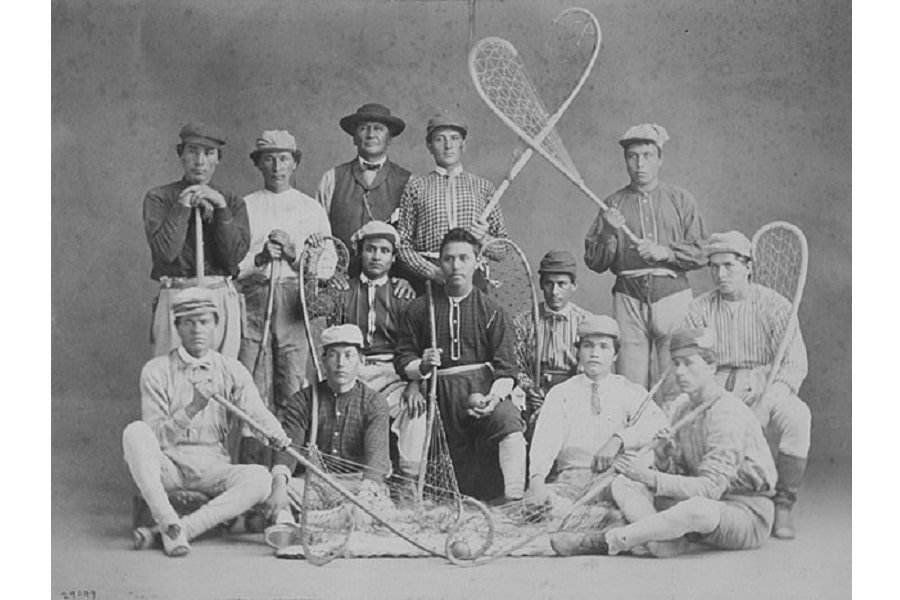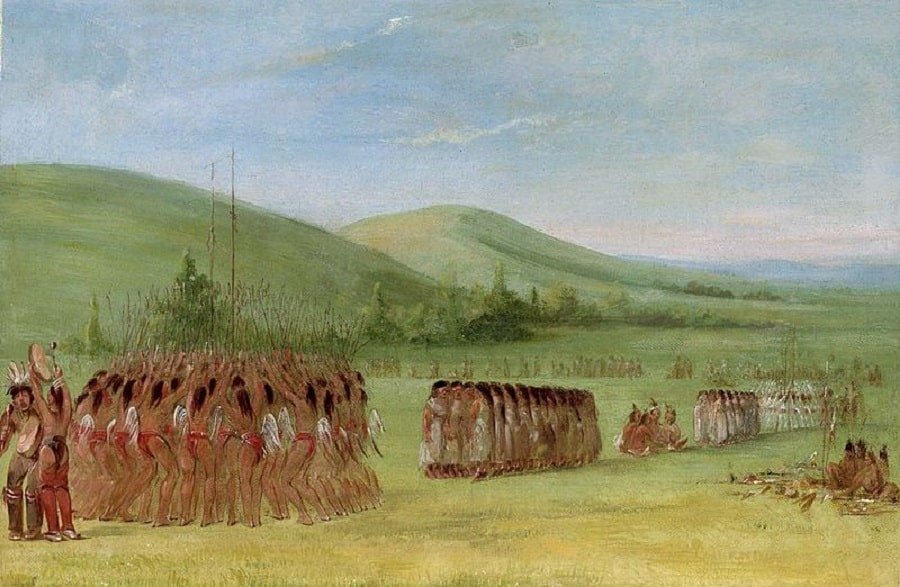The origins of lacrosse can be traced back to various Indigenous peoples of North America, particularly those in the eastern part of the continent. The game has a long history and holds great cultural significance for these communities.
Over the years, the game has grown to transcend cultural boundaries and captivate athletes and enthusiasts around the world. Today, lacrosse is played at various levels, ranging from youth leagues to collegiate and professional competitions. Its popularity continues to expand as more individuals are drawn to its fast-paced nature, strategic gameplay, and exhilarating matches.
Table of Contents
What are the Origins of Lacrosse?

Lacrosse finds its roots deeply embedded in Native American culture, making it one of the few sports indigenous to North America [3]. Native American tribes, spanning different regions and nations, played variations of the game long before European settlers arrived on the continent. It is believed that lacrosse originated as early as the 12th century and was an integral part of Native American life. The game held significant cultural, social, and spiritual importance among these communities [1].
For many tribes, lacrosse was not simply a sport but a reflection of their beliefs and way of life. The game often carried symbolic meanings, representing aspects of warfare, fertility, and communal harmony. It was regarded as a gift from the Creator, a sacred activity that brought people together and embodied the values and principles cherished by Native American societies. The spiritual connections to the natural world were evident in the rituals, ceremonies, and prayers performed before and after the games [4].
READ MORE: Native American Gods and Goddesses: Deities from Different Cultures
Tracing Back the History of the Sport
While specific details and timelines vary across different tribes and regions, there is evidence to suggest that lacrosse was played for centuries before the arrival of Europeans [1].
Ancient rock art and artifacts provide glimpses into lacrosse-like games being played by Indigenous peoples long ago. These historical remnants, along with accounts from early explorers and settlers, allow us to piece together the early origins of the game. The first formalized set of rules for lacrosse was developed by the Montreal Lacrosse Club in the mid-19th century, contributing to the standardization of the sport.
As European colonization unfolded, lacrosse caught the attention of settlers, who observed and documented the game. The encounters between Native American tribes and European settlers led to cultural exchanges, which influenced the evolution of lacrosse [3]. The introduction of new equipment, modified rules, and the adoption of some elements from European stick-and-ball games all contributed to the transformation of the game over time [1].

READ MORE: Who Discovered America: The First People Who Reached the Americas
Rules of the Game
Objective
The objective of the game was to score goals by shooting a small ball into the opposing team’s goal. The team that scored the most goals would win the game [3].
Field
Lacrosse was typically played on a large open field or a designated playing area. The size of the field could vary, but it was generally much larger than modern lacrosse fields [3].
Teams
The game involved two teams, each consisting of numerous players. The number of players on a team could range from a few individuals to several dozen, depending on the specific tribal traditions and variations of the game [3].
Equipment
Players used a stick known as a crosse or racquet to handle the ball. Traditional crosses were typically made of wood and featured a woven netting at the end to catch and carry the ball. The size and design of the crosses could vary among tribes [3].
Gameplay
Lacrosse was a highly energetic and physically demanding game. Players used their crosses to pass, catch, and carry the ball. The ball was typically made of wood, deerskin, or other materials. The game involved running, dodging opponents, and strategic teamwork to move the ball toward the opposing team’s goal [3].
Rules
While the specific rules varied among tribes, there were general guidelines regarding player conduct, such as avoiding unnecessary violence or dangerous play. Some tribes had rules that prohibited players from touching the ball with their hands, while others allowed limited use of hands in certain situations [3].

Native American Connection: Who Created Lacrosse?
Lacrosse stands as a testament to the ingenuity and creativity of Indigenous peoples, who are universally recognized as the creators of the game. Native American tribes developed lacrosse in response to their physical, social, and spiritual needs. It is believed that lacrosse originated as early as the 12th century, with various tribes across North America embracing the game and adapting it to suit their specific cultural contexts [2].
The Native American creation stories and oral traditions often attribute the origin of lacrosse to celestial beings, animal spirits, or mythical figures. For example, the Haudenosaunee (Iroquois) people trace the beginnings of lacrosse to the legend of the game being given to them by the Creator. These stories not only highlight the spiritual connections Indigenous peoples have with the game but also emphasize its sacred nature and cultural significance [4].
Tribes and Cultures Associated with the Development of the Game
Numerous Native American tribes played integral roles in the development and preservation of lacrosse. Among them, the Haudenosaunee (Iroquois) Confederacy holds a particularly significant place in the history of lacrosse. Lacrosse was not merely a sport for them; it was a ceremonial activity that embodied their values of unity, respect, and harmony. The Haudenosaunee Nationals, representing the Six Nations Confederacy, continue to showcase their traditional style of play in international lacrosse tournaments, exemplifying the enduring connection between Indigenous cultures and the game [3].
Other tribes such as the Cherokee, Choctaw, Ojibwe, and many more also had their variations of lacrosse. Each tribe had its own distinct rules, equipment, and cultural practices associated with the game. For instance, the Cherokee played a game called “Anetsa” that emphasized endurance and agility, while the Choctaw engaged in “Kapucha Toli,” which involved the use of long sticks and a smaller ball. These tribal variations highlight the diversity and regional adaptations of lacrosse, as different Native American cultures embraced and customized the game according to their specific needs and traditions [2].

The Original Name of Lacrosse
Lacrosse, known by different names among Native American tribes, highlights the linguistic and cultural diversity within Indigenous communities. The Haudenosaunee (Iroquois) people referred to the game as “Tewaarathon,” which carries deep symbolic meaning. “Tewaarathon” translates to “little brother of war,” signifying the game’s connection to warfare and its role in training young warriors. It also signifies “the creator’s game,” recognizing the spiritual significance of lacrosse in Haudenosaunee culture [2]. The Cherokee people called the game “Anetsa,” emphasizing its importance as a social and ceremonial activity. For the Ojibwe, lacrosse was known as “Baaga’adowe,” which translates to “the net game,” referring to the use of nets to catch and throw the ball. The Choctaw people called it “Kapucha Toli,” which means “stick ball,” highlighting the primary equipment used in the game. These diverse names demonstrate the nuanced understanding and contextual relevance of lacrosse within different Native American tribes [4].
Importance of the Game in Native American Societies
Lacrosse held profound significance within Native American societies, reaching beyond mere entertainment or competition. It served as a cultural pillar, interwoven into the social fabric and spiritual beliefs of Indigenous communities [1]. Lacrosse contests were often accompanied by rituals, songs, dances, and ceremonies, infusing the game with a deeper spiritual dimension. These rituals connected players with their ancestors, sought blessings from the natural world, and honored the spirits guiding the game. Lacrosse also served as a platform for transmitting essential values and life skills. Players learned the importance of teamwork, discipline, and respect for opponents, reflecting the communal values upheld by Native American societies. The game fostered social bonds, promoted physical fitness, and provided a means for resolving conflicts peacefully. Moreover, lacrosse held healing properties and played a role in spiritual and cultural ceremonies associated with fertility, harvest, and renewal [3].

Invention and Evolution of Lacrosse
In the Great Lakes region, a game called “Baggataway” was played by tribes such as the Ojibwe and Odawa. As European colonization took place, lacrosse caught the attention of explorers and settlers, leading to written accounts and descriptions of the game. In the mid-19th century, the first formalized set of rules for lacrosse was created by the Montreal Lacrosse Club in Canada, contributing to the standardization of the sport. By the late 1800s, lacrosse spread across North America, with the formation of leagues and the growth of competitive play. In the 20th century, lacrosse continued to evolve, with the introduction of protective gear, changes in equipment design, and the establishment of international governing bodies, such as the Federation of International Lacrosse [1].
Lacrosse’s Place in History: Oldest Sport in America?
Lacrosse’s claim as one of the oldest sports in America is supported by several factors, including its continuous presence throughout history and its deep-rooted connection to Native American cultures. Unlike many other traditional indigenous games that have faded away over time, lacrosse has endured and continues to be played today, showcasing its historical significance and cultural resilience. The game has been passed down through generations, preserving its traditions, techniques, and rules [3].
The Haudenosaunee (Iroquois) Confederacy provides a compelling example of lacrosse’s longstanding history. They have been playing lacrosse for over a thousand years, making it one of the oldest recorded sports in North America. The Haudenosaunee regard lacrosse as a sacred game, embodying spiritual and cultural aspects that extend beyond mere competition. The game’s spiritual significance is evident in rituals, prayers, and ceremonies associated with its practice. This deep-rooted connection between lacrosse and Native American spirituality highlights its historical importance and underscores its claim as one of the oldest sports in America [4].

Cultural Significance: Why Did Native American Tribes Play Lacrosse?
Lacrosse held profound spiritual, social, and ceremonial significance among Native American tribes, deeply ingrained in their belief systems and cultural practices. The game was seen as a sacred tradition that went beyond its physical aspects. It was seen as a spiritual endeavor, connecting players to their ancestors and the natural world. The stick used in lacrosse was believed to have symbolic power and represented the unity of the physical and spiritual realms [2].
Prior to lacrosse games, elaborate rituals and ceremonies were performed to prepare the players and seek blessings from the spirits. These rituals involved purification ceremonies, offerings, and prayers to ensure a fair and honorable competition. For instance, the Haudenosaunee people had a ritual known as the “medicine game” where players would undergo spiritual purification, seeking guidance and strength from the spiritual realm. This spiritual connection was an integral part of the game, demonstrating the tribes’ belief in the interconnectedness of all things and their reverence for the game as a sacred cultural practice [4].
Lacrosse also played a significant social role within Native American societies. It served as a means of community building, fostering social bonds, and strengthening relationships among individuals and tribes. Lacrosse contests provided opportunities for tribes to come together, promoting cultural exchange and understanding. These gatherings were not only for the players but also attracted spectators from different tribes who would gather to witness the skill and athleticism of the players. The games became important social events, accompanied by festivities, feasts, storytelling, and dances. They created a platform for tribes to interact, forge alliances, resolve conflicts, and engage in diplomacy, thereby contributing to the social fabric of Native American communities [2].
Role of Lacrosse in Promoting Physical Fitness and Teamwork
Lacrosse played a vital role in promoting physical fitness, athleticism, and teamwork within Native American communities. The game required players to possess strength, agility, coordination, and endurance. Through the rigorous physical demands of lacrosse, players developed these attributes and enhanced their overall physical fitness. The game served as a form of physical training, preparing individuals for the challenges of everyday life, such as hunting, gathering, and defending their communities [1].
Moreover, lacrosse emphasized the importance of teamwork and collaboration. Successful gameplay relied on effective communication, coordination, and strategizing among teammates. The game encouraged players to work harmoniously towards a shared objective, fostering a sense of unity and cooperation within the team and the broader community. The skills learned through lacrosse, such as teamwork, discipline, adaptability, and leadership, were highly valued and applicable to various aspects of tribal life beyond the game itself.
For example, among the Cherokee people, lacrosse was used as a means to teach young warriors the values and skills necessary for warfare. The game’s fast pace, physicality, and strategic elements served as a metaphor for battle. It taught warriors the importance of selflessness, sacrifice, and collective effort in defending their communities. Lacrosse contests among tribes also allowed warriors to showcase their skills and prowess, earning them respect and status within their respective societies [1].
References
- Fisher, D. M. (2011). Lacrosse: A History of the Game. JHU Press.
- Vennum, T., Jr. (2008). American Indian Lacrosse: Little Brother of War. JHU Press.
- Pietramala, D. G., & Grauer, N. A. (2006). Lacrosse: Technique and Tradition. JHU Press.
- Downey, A.. (2022). The Creator’s Game: Lacrosse, Identity, and Indigenous Nationhood. University of Nebraska Press.